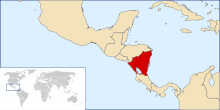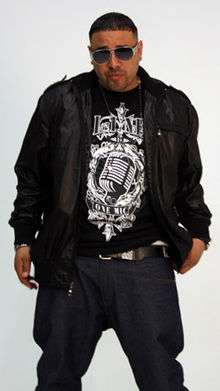Nicaraguan Americans
| ||||||||||
| Total population | ||||||||||
|---|---|---|---|---|---|---|---|---|---|---|
|
405,601[1]  | ||||||||||
| Regions with significant populations | ||||||||||
| Metropolitan Miami, Greater Los Angeles, San Francisco Bay Area, New York City, Washington Metro Area, Inland Empire, Houston, New Orleans Metro | ||||||||||
| Languages | ||||||||||
| Spanish, English | ||||||||||
| Religion | ||||||||||
| Roman Catholic, Protestantism | ||||||||||
A Nicaraguan American (Spanish: nicaraguo-americano, norteamericano de origen nicaragüense or estadounidense de origen nicaragüense) is an American of Nicaraguan descent.
The Nicaraguan American population at the 2010 Census was 348,202. Nicaraguans are the eleventh largest Hispanic group in the United States and the fourth largest Central American population.
More than two-thirds of the Nicaraguan population in the US resides in California or Florida.
In California, Nicaraguans are more dominant in the Greater Los Angeles Area and San Francisco Bay Area. Large populations also reside in the Inland Empire and the cities of Sacramento, San Diego, and San Jose.
In Florida, 90% of Nicaraguans reside in the Miami Metropolitan Area. Miami-Dade County is home to 30% of Nicaraguans residing in the US.
Immigrational history
Nicaraguans have immigrated to the United States in small groups since the early 1900s, but their presence was especially felt over the last three decades of the 20th century. The Nicaraguan community is mainly concentrated in three major urban areas: Metropolitan Miami, Greater Los Angeles, and San Francisco Bay Area. A more affluent group of Nicaraguan Americans reside in the New York metropolitan area.
According to Immigration and Naturalization Service figures, 23,261 Nicaraguans were admitted as permanent residents between 1976 and 1985; 75,264 were admitted between 1986 and 1993; and 94,582 between 1994 and 2002, with a total of 193,107 Nicaraguan immigrants being granted legal status since 1976.[2]
The earliest documents of immigration from Nicaragua to the United States was combined in total with those of other Central American countries. However, according to the U.S. Census Bureau some 7,500 Nicaraguans legally immigrated from 1967 to 1976. An estimated 28,620 Nicaraguans were living in the U.S. in 1970, 90% of which self-reported as white on the 1970 census. Most Nicaraguan immigrants during the late 1960s were women: there were only 60 male Nicaraguan immigrants for every 100 female immigrants during this period.[3]
Over 62 percent of the total documented immigration from 1979 to 1988 occurred after 1984.[4] In 1998 more than two million Nicaraguans were left homeless due to hurricane Mitch, as a result many Nicaraguans received permanent residence or temporary protected status (TPS) in the late 1990s.[5]
According to the 1990 U.S. Census 168,659 of the total 202,658 documented Nicaraguans in the U.S. were born in Nicaragua.[6] In 1992 approximately 10–12% of the Nicaraguan population had emigrated. These emigrants tended to be disproportionately of working age, better educated, and more often white-collar workers than nonmigrants. In addition, emigrants were more likely to come from larger premigration households and higher income households.[4]
Motives for emigration
The Sandinista revolution that started in the mid-1970s and the Contra war that followed brought the first large waves of Nicaraguan refugees into the U.S.[7] As a result of the de-privatization reforms under the FSLN's rule (from 1979 to 1990), the first wave of approximately 120,000 Nicaraguans left Nicaragua and entered the United States.[8]
They consisted mainly of large landholders, industrialists, and managers of North American enterprises. Many Nicaraguan upper-class exiles had economic roots in the United States and in Miami before the upheaval.[8] This phase of upper-class arrivals included exiled dictator Anastasio Somoza Debayle and his family, who owned homes in Miami and were among the richest people in Florida (ibid).
Another major wave of Nicaraguans to the United States, consisting primarily of bluecollar workers, peaked in the dramatic exodus of early 1989.[9] Again, their motivation for migration was escape from both political and economic torment in their homeland. By the late 1980s, the war, Hurricane Joan in 1988, and a severe drought in 1989 left the country in economic ruins. Many of these Nicaraguan immigrants settled in poor and deteriorated sections of Miami, where struggling Cubans who came during the Mariel boatlift exodus of 1980 had previously lived.[10]
Many Nicaraguans who immigrated did so to escape poverty. In Santa Clara County, California, the Nicaraguan public benefits recipients reported that in their families, 43% have one self-employed person or business owner, and 14% of the families have two such persons.[5]
However, nearly all of the estimated 200,000 Nicaraguans who fled to the U.S. (and other nearby Central American countries) between 1978 and 1979 returned after the victory of the Sandinistas in 1979.[11]Unlike the overwhelming majority of Hispanic-Americans and similar to their cuban counterparts in Miami, two-thirds of Nicaraguan-americans align themselves with conservatism and the republican party. The liberal party in Nicaragua is center-right and not left like in the developed world and hasn't been since the 30's and the influence President Roosevelt had on Anastasio Somoza. The conservative wing of the Catholic church has had a particularly strong effect on the nation's anti-left population for half a century.
Cultural
Nicaraguan Americans are Spanish-speaking and predominately Catholic. They celebrate the patron saints of the Roman Catholic Church with festivals and processions, which also provide a context for artistic and cultural expressions of the local identity. The most important patronal festivals for communities in Florida include Santa Ana, San Sebastian, La Purisima, San Jeronimo and La Griteria.[2]Nicaragua is one of the most traditionalist countries in the Americas and so the majority of Nicaraguans define themselves as socially conservatives regardless of party affiliations or place of residence within the United States.
Demographics
Outside of California and Florida, Nicaraguans can also be found in New York City, New Orleans Metro, and the Washington Metropolitan Area. Cities with noticeable Nicaraguan populations also include Charlotte, Houston, Jersey City, and Camden, New Jersey, Milwaukee, Madison Wisconsin The Amigos de las Americas program set in motion by John F. Kennedy in the early 60's promoted the sisterhood between States of the USA and third world countries. Wisconsin is the original sister State to Nicaragua. Employment and Student exchange programs in the past were the main reason for the first Nicaraguan to arrive and settle in that Midwest Sate.
States
The 10 states with the largest population of Nicaraguans (Source: 2010 Census):
- Florida - 135,143
- California - 100,790
- Texas - 19,817
- New York - 13,006
- New Jersey - 8,222
- Maryland- 8,196
- Virginia - 7,388
- Louisiana - 6,390
- North Carolina - 4,964
- Georgia - 4,787
Areas
The largest population of Nicaraguans are situated in the following areas (Source: Census 2010):
- Miami-Fort Lauderdale-Pompano Beach, FL MSA - 118,768
- Los Angeles-Long Beach-Santa Ana, CA MSA - 40,607
- San Francisco-Oakland-Fremont, CA MSA - 30,807
- New York-Northern New Jersey-Long Island, NY-NJ-PA MSA - 17,987
- Washington-Arlington-Alexandria, DC-VA-MD-WV MSA - 14,187
- Riverside-San Bernardino-Ontario, CA MSA - 9,793
- Houston-Sugar Land-Baytown, TX MSA - 9,496
- New Orleans-Metairie-Kenner, LA MSA - 5,310
- San Jose-Sunnyvale-Santa Clara, CA MSA - 4,540
- Orlando-Kissimmee-Sanford, FL MSA - 4,083
- Dallas-Fort Worth-Arlington, TX MSA - 3,964
- Atlanta-Sandy Springs-Marietta, GA MSA - 3,719
- Las Vegas-Paradise, NV MSA - 3,587
- Sacramento-Arden-Arcade-Roseville, CA MSA - 3,269
- Philadelphia-Camden-Wilmington, PA-NJ-DE-MD MSA - 3,163
- Chicago-Joliet-Naperville, IL-IN-WI MSA - 2,928
- Tampa-St. Petersburg-Clearwater, FL MSA - 2,589
- Phoenix-Mesa-Glendale, AZ MSA - 2,169
- San Diego-Carlsbad-San Marcos, CA MSA - 2,025
- Charlotte-Gastonia-Rock Hill, NC-SC MSA - 1,912
- Vallejo-Fairfield, CA MSA - 1,750
- Austin-Round Rock-San Marcos, TX MSA - 1,714
- Seattle-Tacoma-Bellevue, WA MSA - 1,635
- San Antonio-New Braunfels, TX MSA - 1,547
- Boston-Cambridge-Quincy, MA-NH MSA - 1,438
US communities with largest population of people of Nicaraguan ancestry
The top 25 US communities with the highest populations of Nicaraguans (Source: Census 2010)
- Miami - 28,618
- Los Angeles - 15,572
- Hialeah, Florida - 10,410
- San Francisco - 7,604
- Fontainebleau, Florida - 6,738
- Houston, Texas - 4,226
- Kendale Lakes, Florida - 3,560
- Tamiami, Florida - 3,476
- Sweetwater, Florida - 3,102
- San Jose, California - 2,917
- Kendall, Florida - 2,629
- The Hammocks, Florida - 2,391
- Kendall West, Florida - 2,265
- Miami Gardens, Florida - 2,134
- West Little River, Florida - 2,112
- Richmond West, Florida - 2,039
- Miami Lakes, Florida - 1,772
- Hayward, California - 1,745
- Miramar, Florida - 1,691
- South San Francisco, California - 1,639
- South Miami Heights, Florida - 1,585
- Metairie, Louisiana - 1,462
- Pembroke Pines, Florida - 1,423
- Homestead, Florida - 1,354
- Hialeah Gardens and Hollywood, Florida - 1,321
US communities with high percentages of people of Nicaraguan ancestry
The top 25 US communities with the highest percentages of Nicaraguans as a percent of total population (Source: Census 2010)
- Sweetwater, Florida - 22.98%
- Fontainebleau, Florida - 11.27%
- Miami, Florida - 7.16%
- Richmond West, Florida - 6.38%
- Kendale Lakes, Florida - 6.34%
- Tamiami, Florida - 6.29%
- Kendall West, Florida - 6.26%
- West Little River, Florida - 6.09%
- Hialeah Gardens, Florida - 6.08%
- Brownsville, Florida - 5.66%
- Stock Island, Florida - 5.66%
- Medley, Florida - 4.89%
- Princeton, Florida - 4.89%
- Gladeview, Florida - 4.83%
- The Hammocks, Florida - 4.69%
- Hialeah, Florida - 4.63%
- South Miami Heights, Florida - 4.44%
- University Park, Florida - 4.32%
- Rollingwood, California - 4.14%
- Palmetto Estates, Florida - 4.13%
- Colma, California - 4.02%
- Miami Lakes, Florida and Country Walk, Florida - 3.90%
- The Crossings, Florida - 3.89%
- Country Club, Florida - 3.76%
- Westwood Lakes, Florida - 3.72%
Nicaraguan Americans

- Marvin Benard, a Major League Baseball player
- Maurice Benard, an actor on American soap operas All My Children and General Hospital.
- Randy Caballero, (born March 18, 1991 in Coachella, California) is an undefeated Nicaraguan American professional boxer in the Featherweight division
- Barbara Carrera, film and television actress, best known for her roles as Bond girl Fatima Blush in Never Say Never Again and as Angelica Nero on the soap opera Dallas.
- Oswaldo Castillo, actor, most notable role includes the one in The Hammer.
- Michael Cordúa (1961), restaurateur, entrepreneur, businessman, award winning self-taught chef.
- DJ Craze, only DJ in history to win 3 consecutive World DMC Champion titles.
- Salomón de la Selva, poet, author of Tropical Town and Other Poems
- Miguel D'Escoto, Roman Catholic priest and former foreign minister.
- Omar D'León, a painter and poet.
- Bill Guerin, an NHL hockey player for the Pittsburgh Penguins.
- Edward'O, an astronalyst and co-host of 12 Corazones.
- Bianca Jagger, human rights advocate and ex-wife of Mick Jagger.
- Diana López, Olympic bronze medalist in the sport of taekwondo.
- Mark López, Olympic silver medalist in the sport of taekwondo.
- Steven López, two time Olympic gold medalist in the sport of taekwondo.
- Dennis Martínez, a Major League Baseball Player (1976–1998).
- Camilo Mejía, a former Staff Sergeant of the Florida National Guard and anti-war activist
- Lester Meléndez (1981), professional soccer player for the University of Miami.
- T-Bone, rapper.
- Tony Meléndez, singer, composer, writer and musician who was born with no arms.
- Christianne Meneses Jacobs, publisher of Iguana, the United States' only Spanish-language magazine for children.[12]
- Franck de Las Mercedes, a painter
- Ana Navarro, Republican strategist and political commentator
- David Obregón, a professional boxer
- Claudia Poll, Nicaraguan born swimmer.
- Silvia Poll, Nicaraguan born swimmer.
- Horacio Peña, professor, writer, and poet.
- Hope Portocarrero, former First Lady of Nicaragua (1967–1978).
- Anastasio Somoza Portocarrero - son of former Nicaraguan president Anastasio Somoza Debayle and Hope Portocarrero de Somoza
- James Quesada, anthropologist and professor.
- Mari Ramos, weather anchor for CNN.
- Hilda Solis, U.S. congresswoman and the 25th United States Secretary of Labor.
- Eve Torres, WWE Diva, professional wrestler
- J Smooth, a bi-lingual hip hop and reggaeton singer.
- Torombolo, a reggaeton singer.
- Gabriel Traversari, actor, director, writer, singer, songwriter and painter.
- Donald Vega, jazz musician and composer.
- Nastassja Bolívar, Nuestra Belleza Latina 2011, Miss Nicaragua 2013, Top 16 at Miss Universe 2013
- Luis Enrique, Principe de la Salsa.
- Barbara Carrera, Actriz de Hollywood, Chica Bond.
- Claudio Villanueva]], University of Utah Professor.
References
- 1 2 US Census Bureau 2012 American Community Survey B03001 1-Year Estimates HISPANIC OR LATINO ORIGIN BY SPECIFIC ORIGIN retrieved September 20, 2013
- 1 2 Encyclopedia Latina: History, Culture, And Society In The United States, Book 3
- ↑ Orlov, Ann; Reed Veda (1980). "Central and South Americans," Harvard Encyclopedia of American Ethnic Groups. Harvard University Press. pp. 210–217.
- 1 2 Funkhouser, Edward (1992). Migration from Nicaragua: Some Recent Evidence. World Development, Volume 20. p. 1210.
- 1 2 "Context for Nicaraguan Immigration". Retrieved 2007-05-24.
- ↑ "1990 U.S. Census". U.S. Census Bureau. 1990. Retrieved 2007-05-24.
- ↑ H. Lundquist, Jennifer; Douglas S. Massey (2005). The Contra War and Nicaraguan Migration to the United States. Journal of Latin American Studies. pp. 29–53.
- 1 2 Konczal, Lisa. Nicaraguan Immigrants. In Multicultural America: An Encyclopedia of the Newest Americans edited by Ron Baylor. Greenwood Press, 2011, p. 1566.
- ↑ Portes, Alejandro and Alex Stepick. City on the Edge: The Transformation of Miami. Berkeley: University of California Press, 1993, p. 152.
- ↑ Konczal, Lisa, p. 1567.
- ↑ Y. Hamamoto, Darrell; Rodolfo D. Torres (1997). New American Destinies: A Reader in Contemporary Asian and Latino Immigration. Routledge. p. 108. ISBN 0-415-91768-9.
- ↑ Sowers, Carol. "Children's magazine creator receives entrepreneur award". The Arizona Republic. Retrieved 2007-09-27.
External links
- Historical Museum Folklife of Miami's Nicaraguan Communities






